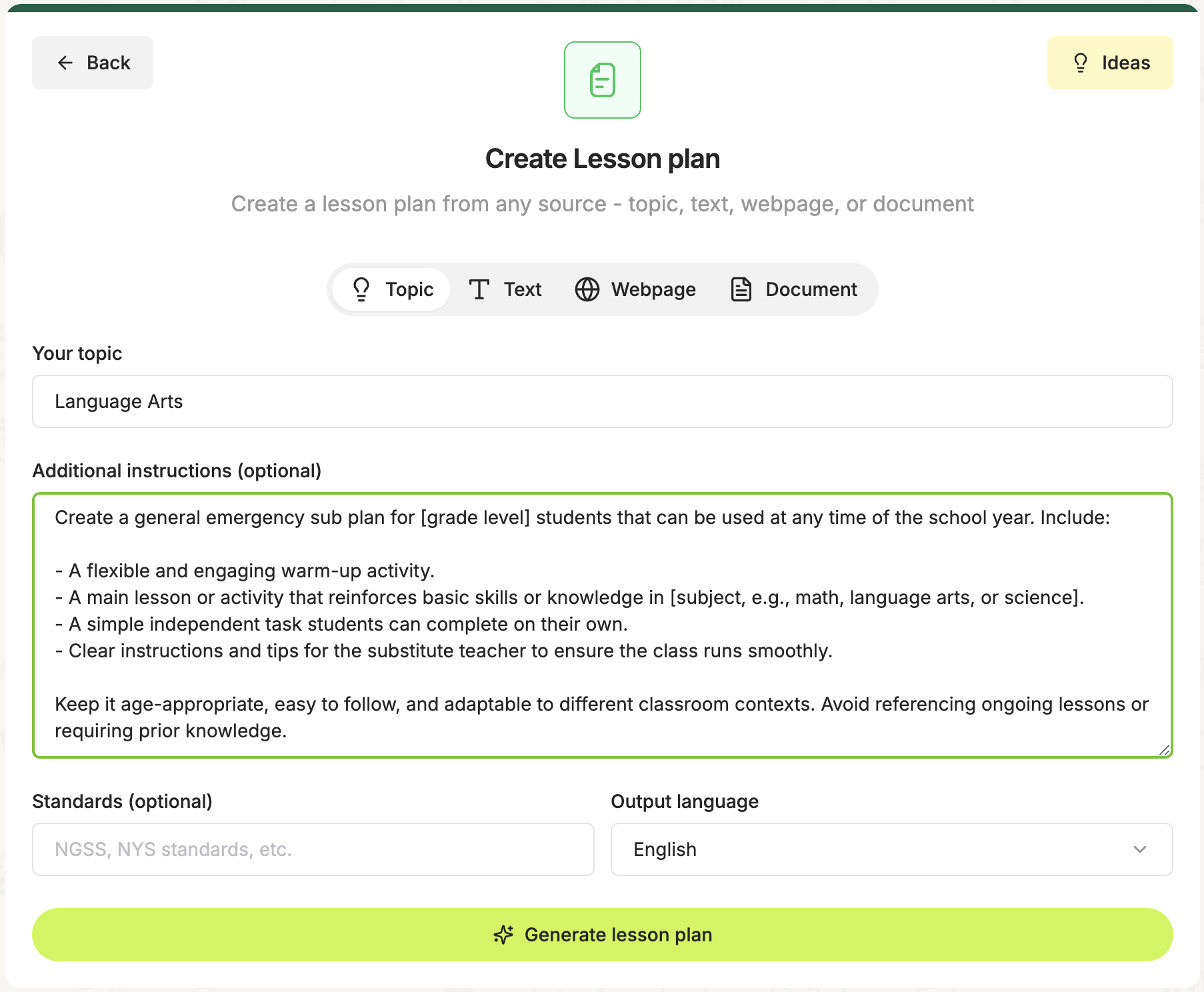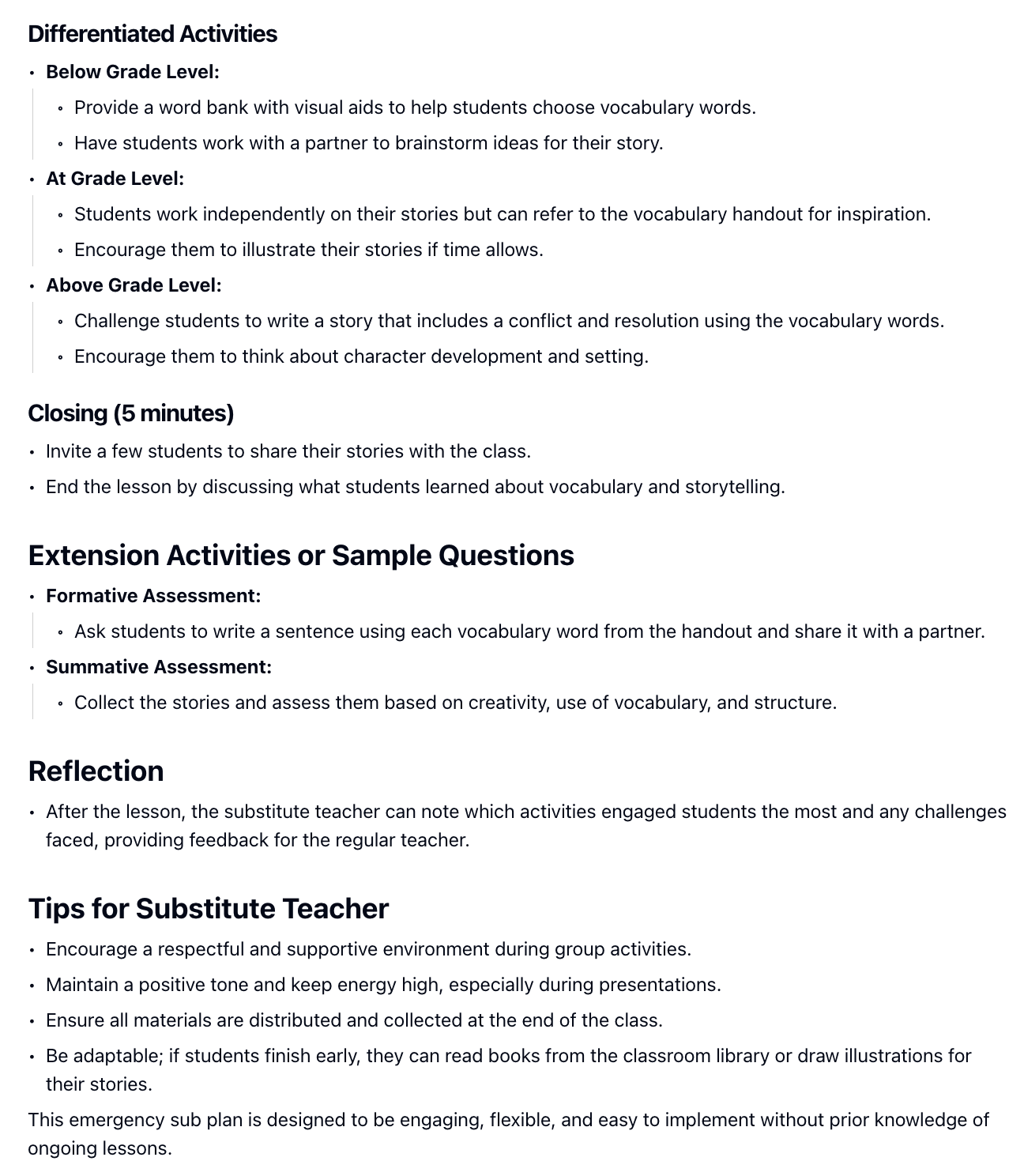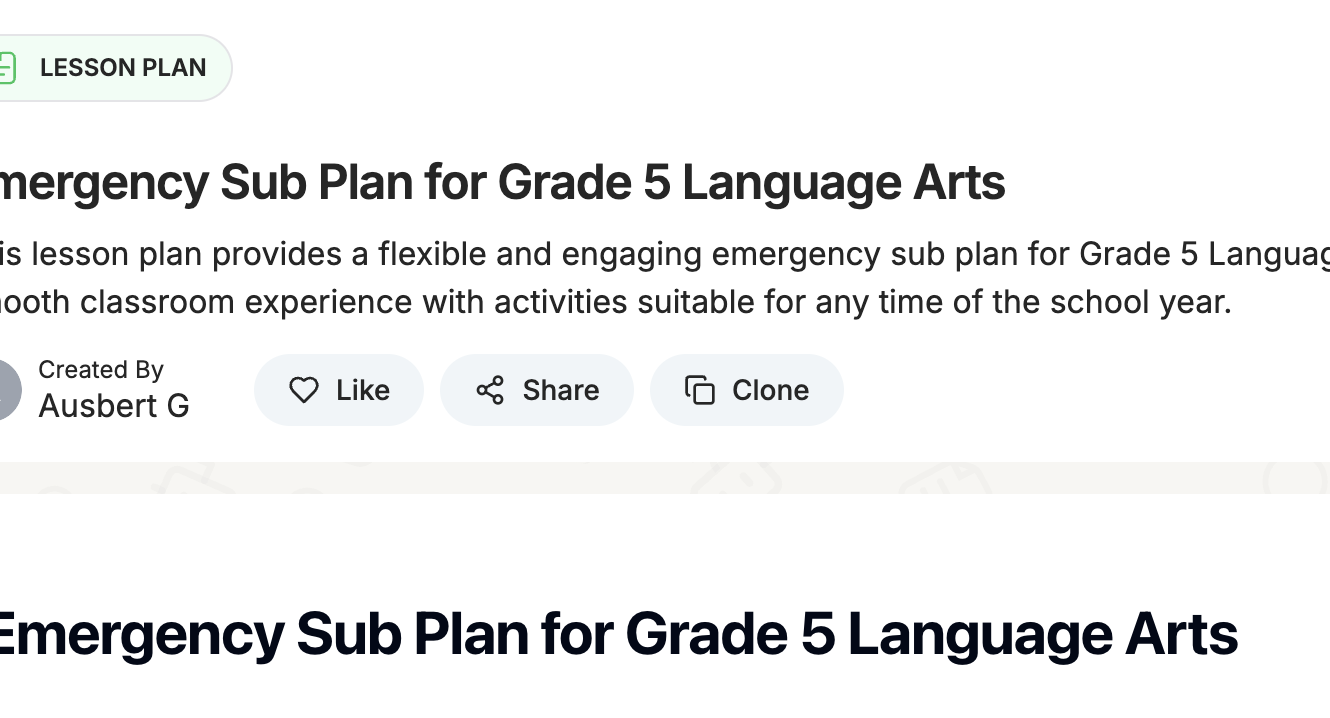Your 10-Point Checklist for Emergency Sub Plans (Templates Included)
Introduction
Going on an emergency absence is just as stressful for you as it is for the substitute teacher stepping in. Without a well-thought-out plan, your absence can leave gaps in instruction, disrupt the classroom flow, and create challenges for everyone involved. Foreseeing these situations and having effective emergency sub plans in place can save the day.
It’s tough to plan for the unknown. Emergencies are, by nature, unpredictable. But while you can’t predict when or why you’ll need them, you can prepare a set of plans that work in any scenario. The key is creating something that’s flexible, and easy to execute. Here are a few essential ideas to help you prepare for the unpreparable:
- Have a consistent structure for every plan. This ensures substitutes know exactly where to look and how to follow through, no matter the subject or grade.
- Include detailed classroom routines and expectations. A clear outline of procedures makes it easier to maintain a sense of normalcy for your students.
- Prepare engaging, standalone activities. Choose tasks that don’t require much context but still provide value and align with your objectives.
What Are Emergency Sub Plans
Emergency sub plans are pre-prepared lesson plans designed for unexpected teacher absences. These plans are meant to provide substitutes with all the necessary resources, and to-dos to ensure the classroom runs smoothly in the teacher’s absence. Unlike regular sub plans that are often created for planned absences, emergency sub plans are generic enough to work at any time but still effective in maintaining classroom structure and learning continuity.
The primary purpose of emergency sub plans is to minimize disruptions to learning. They typically include lesson activities that are self-contained, and not dependent on ongoing class progress. These plans often include:
- step-by-step instructions,
- student rosters,
- seating charts,
- classroom rules,
- and any additional resources substitutes might need to handle the day efficiently.
Emergency Sub Plans vs. Regular Sub Plans
While substitutes rely on both emergency and regular sub plans to guide them, these two serve entirely different purposes. Emergency sub plans are designed for unforeseen situations, ensuring a classroom can run smoothly without immediate teacher input. Regular sub plans, on the other hand, are crafted for planned absences and align with specific lessons or events.
Here’s a detailed comparison:
| Aspect | Emergency Sub Plans | Regular Sub Plans |
|---|---|---|
| Purpose | Serve as a contingency for unexpected absences like sudden illness or emergencies. | Used for planned leaves, such as professional development days or vacations. |
| Content Focus | General, standalone activities that don’t depend on prior lessons or ongoing curriculum progress. | Specific, detailed lessons that fit directly into the current teaching plan. |
| Preparation Timeline | Created and stored in advance for immediate use, often left in a dedicated folder. | Prepared just before the planned absence, based on the timeline and objectives of the ongoing curriculum. |
| Details Provided | Includes basic classroom routines, general instructions, and simple, adaptable lessons. | Contains detailed lesson steps, handouts, and specific objectives that fit the class’s learning trajectory. |
| Substitute’s Role | Guides students through pre-set routines and activities, focusing on maintaining order and engagement. | Directly facilitates the planned lesson, often acting as a temporary instructor for specific topics. |
| Flexibility of Use | Can be used anytime and adjusted to suit various grade levels and contexts. | Strictly tied to the timing and progression of a specific subject or unit. |
| Examples of Activities | Fun worksheets, independent reading tasks, or review games that reinforce previous learning. | Advanced math problems, ongoing projects, or new concepts tied to current lessons. |
Creating AI-Powered Emergency Sub Plans
By leveraging artificial intelligence, you can generate tailored lesson plans that are ready to use in any situation. These tools help create content that’s adaptable and engaging, even when you’re unavailable to guide the classroom directly.
Here’s how AI can enhance your emergency sub plans:
- Customizable templates for every grade level. AI platforms can quickly generate lesson structures based on the age group and subject, ensuring relevance and appropriateness.
- Quick generation of diverse activities. Whether you need a vocabulary-building exercise, a math worksheet, or a science experiment guide, AI tools can produce options in seconds.
- Seamless integration with existing materials. Many AI tools can analyze your current resources and expand on them, creating a cohesive plan that feels like an extension of your teaching style.
- Readymade instructions for substitutes. AI can write clear, step-by-step instructions to make it easier for substitutes to follow through on your plans.
Emergency Sub Plans in Seconds with Edcafe AI
All things considered, Edcafe AI fits quite the bill. With Edcafe AI, you can create lesson plans but, most importantly, customize them into emergency sub plans. At the end of the day, with any AI out there, prompt engineering is key.
But with Edcafe AI, that’s a lot easier. With guided prompt fields, I easily created an emergency sub plan in seconds.
Emergency sub plans, as we’ve agreed, are flexible at best. So, if you’re teaching a specific subject, you can either stick to that subject or focus on something related. This ensures you don’t disrupt learning continuity by introducing an entirely new topic during your emergency absence.
Let’s say you’re a Language Arts teacher and need emergency sub plans. Here’s exactly what I fed into Edcafe AI:

And just like that, Edcafe AI generated a complete emergency sub plan that was flexible, and ready to use. Here are essential sections that are included with the prompt I used:
- Lesson hooks
- Guided practice
- Differentiated activities
- Notes for substitute teachers

data-title="Create emergency sub plans with Edcafe AI for free"
data-description="Create AI lesson plans, slides, flashcards, images, chatbots, and more in seconds. Sign up for a forever free account today."
data-product="edcafe"
>
16 Customizable Emergency Sub Plan Templates for Every Subject
With Edcafe AI, sharing resources is easy. Below, I’m sharing 16 emergency sub plans for different subjects that you can duplicate and customize to your liking. To do so, just visit the links and click on ‘Clone‘:

Access these free emergency sub plan templates:
- Language Arts – Grade 5
- Math – Grade 3
- Science – Grade 5
- Social Studies – Grade 7
- Literacy – Kindergarten
- History – Grade 10
- Art – Grade 3
- Music – Grade 4
- Health – Grade 8
- Physical Education – Grade 6
- Computer Science – Grade 7
- Foreign Language – Grade 8
- Technology – Grade 9
- Economics – Grade 10
- Psychology – Grade 11
- Business Studies – Grade 12
10 Must-Haves for Emergency Sub Plans for a Smooth Transition
1. Classroom routines that run on autopilot
Substitutes don’t have the luxury of gradually getting to know the class dynamic. Instead, they must rely on clear and consistent routines to avoid chaos. Provide a step-by-step outline of classroom procedures, from how students should enter the room to how they should submit work. If you use any classroom management tools or strategies, like a point system or behavior chart, make sure that’s included as well.
Why it’s essential: Experienced teachers know that when students know exactly what to expect, they are more likely to stay focused and compliant. Substitutes, who lack familiarity with the students, need those clear guidelines to maintain control and prevent disruptions.
2. A seating chart that does the work
It’s not enough to simply list where students sit. A seating chart should indicate not only student names but also any pre-established student roles, such as group leaders or helpers. Make sure you note any student who has specific classroom needs, such as behavioral accommodations or assistance with tasks. Instruct your substitute to follow these roles, and include tips on managing specific students who might need extra attention.
Why it’s essential: I’ve learned that substitutes struggle when they can’t easily identify students. A well-thought-out seating chart allows the sub to establish order quickly and can prevent any awkward moments, like calling on students out of turn or not knowing who’s who.
3. Key student info at a glance
A generic list of students isn’t enough. In an emergency, you need to anticipate the substitute’s need for critical information on specific students, especially those with special needs, or particular behavior management requirements. Include students with IEPs, 504 plans, or any who require accommodations. If there are students who may need specific prompts or attention, make those notes clear.
Why it’s essential: Knowing who needs extra time, who works well with a peer, and who might be a flight risk can make or break a day for a substitute. A detailed student roster allows the substitute to act proactively, reducing the chances of behavior issues escalating.
4. Lesson plans that don’t need explaining
Don’t just leave a basic “do this” outline. Your lesson plan should be a clear, step-by-step guide that can be followed with little to no input from you. Include any online resources and materials needed, and clarify how each activity ties to broader learning objectives. Include flexibility in the plan so the substitute can adjust depending on time, student behavior, or unforeseen circumstances (like a tech malfunction).
Why it’s essential: Substitutes can get flustered when a plan isn’t clearly laid out. They may try to improvise, and that’s when things go off-track. A well-organized lesson plan gives them the confidence to carry out your vision, even if they’re not familiar with the specific content.
5. Activities that work without you
It’s crucial that the activities in your emergency sub plan are engaging enough to hold students’ attention but also independent enough that they don’t require constant guidance. Design activities that students can complete with minimal intervention, such as reading comprehension exercises, vocabulary games, or review activities.
Why it’s essential: Experienced teachers know that active engagement prevents misbehavior. If a substitute has to manage the class while also trying to explain a complex concept, it will lead to frustration. Activities that are easily understood and require little explanation keep students productive and the class orderly.
6. Materials that are easy to find
Materials should be organized in a way that’s easy for the substitute to locate. If the substitute needs to collect materials from different parts of the classroom, make sure that they know exactly where to find each resource. A well-labeled folder or binder that includes everything they’ll need for the day can save a lot of time and reduce confusion.
Why it’s essential: It’s given knowledge that substitutes don’t have the luxury of time to search for supplies. A disorganized classroom only adds unnecessary stress, so make it easy for them by setting up everything in advance.
7. Crisis protocols that are simple to follow
Emergency protocols are non-negotiable. Every sub plan should include detailed instructions for what to do in case of an emergency, including fire drills, lockdowns, or any other crisis scenario. Outline the steps for evacuating the classroom, where to take students, and who to contact in case of medical emergencies. Don’t assume the substitute will be familiar with the school’s procedures.
Why it’s essential: These plans are not optional. You can’t afford to leave the substitute guessing about what to do in an emergency. Clear, accessible emergency protocols ensure everyone is safe and prepared.
8. Tech instructions that don’t overwhelm
With the increasing reliance on technology in classrooms, it’s essential to provide explicit instructions on how to operate any tech tools you’ll be using in your absence. This might include logins for classroom apps, instructions on how to use the projector, or links to online resources.
Why it’s essential: I can tell you that tech issues are one of the most common challenges substitutes face. A tech-savvy sub plan, complete with clear instructions and contingencies for common issues, prevents headaches and keeps the lesson moving forward.
9. A system for student accountability
Provide a system that helps track student progress during the day, especially if the substitute has to assign independent work. Additionally, provide space for the substitute to record any behavioral concerns or notable incidents for you to follow up on.
Why it’s essential: Accountability is key. If a substitute doesn’t have a method for tracking what students are doing, there’s a chance some students could fall off-task. I’ve found that simple systems like this allow the substitute to quickly assess whether students are meeting expectations.
10. A lifeline list for support
Include a list of teachers or staff members the substitute can contact for help if needed. This could include your next-door neighbor teacher, a trusted colleague, or a school admin who can step in if something goes wrong. Make sure the substitute knows how to reach them, whether by phone, email, or in person.
Why it’s essential: Even the most experienced substitute teacher can encounter problems. Having someone to contact makes a huge difference, especially in unusual situations or if a question arises about classroom management or student needs.
data-title="Create emergency sub plans with Edcafe AI for free"
data-description="Create AI lesson plans, slides, flashcards, images, chatbots, and more in seconds. Sign up for a forever free account today."
data-product="edcafe"
>
Comments
Post a Comment